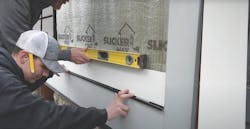Understanding the factors behind this common problem and knowing how to address it effectively is crucial for achieving long-lasting and high-quality results. In this blog, we will delve into everything you need to know about PVC trim, from understanding its movement, common installation mistakes to effective solutions for PVC trim.
What is PVC Trim?
A PVC trim is a durable and versatile material that you can use for various construction and remodeling projects. PVC trims (made from a type of plastic called polyvinyl chloride) are often preferred over traditional wood trims because they are resistant to moisture, rot, and insects, making them ideal for exterior applications. If you're also looking for a low-maintenance, long-lasting, yet easy-to-handle trim material, a PVC trim is easy to cut, shape, and install, saving you time and labor costs.
Understanding PVC Trim Movement
In “Shrinkage: How PVC Trim Moves,” an installment in ProTradeCraft.com’s building science audio series “7 Minutes of BS,” David Parker, director of exterior applications with AZEK Building Products, explains that PVC and wood move for different reasons. Let’s explore the different movements of PVC trim vs wood trim. (The repeating of so many words feels awkward to read is there another way we can accomplish this without keyword stuffing?)
Differences in How PVC Trim VS Wood Trim Moves
Parker explains that PVC moves thermally, whereas a wood-based product moves with moisture. So, wood-based products typically swell, and they swell within their width and a little bit in their length. The difference with PVC is that PVC does not swell or move in its width. It expands and contracts with its length. The problem with PVC trim installs is that remodelers who try to allow for that movement often get it wrong.t
“What people typically run into with PVC,” Parker says, “is that they install it with gaps.” This seems to make sense because, unless it’s a ridiculously hot day, the PVC will expand in the summer and shrink back down in the winter. “That the first season, it does exactly that,” Parker says. “It expands and they may have very few gaps at the ends of their boards that summer, and then that next winter it contracts, as would be expected with PVC—and most building products, for that matter.”
The surprise comes the second summer when the PVC never comes back to full length again.
What happens?
“As with any plastic that goes through a heat cycle,” Parker explains, "there are fibers within the PVC product that relax, and that relaxation … causes it to shrink slightly.” It will expand again as the temperature rises, but after that first year, it will always shrink back to a smaller length than it was when it was installed.
RELATED: How to Install PVC Bevel Siding Over Rainscreen
Effective Solutions for PVC Trim Movement
Are you noticing movement in your client’s PVC trim? This common issue can be frustrating, however, there are effective solutions available to address this problem and ensure a long-lasting, stable trim installation
Proper Installation of PVC Trim
The first part of the solution is proper installation.
- Ensure proper fastening and treatment of field joints, and allow for gaps at the ends of boards.
Tip from Parker: One misconception is that for every 18 feet, you need a ⅛-inch gap at the ends when it’s cold outside. Instead, plan for the fact that the piece of PVC you are working with may eventually end up a bit shorter than it is the day you install it.
- Glue the scarf joints and driving fasteners on your PVC trim board on both sides. This will prevent a gap from opening up in that initial expansion-contraction cycle. The fasteners will keep the board from buckling as it expands, and the boards will stay tightly joined when they “relax.”
Use a detail allowing some movement at the ends of the PVC trim board. This will hide any gaps that develop or at least render them inconspicuous. Or, with a rainscreen system, plan for a small seasonal gap, which may look better than a caulked joint.
RELATED: How to Build a Rainscreen for Open-Joint Cladding
Pay Attention to the Paint for PVC Trim
The second part of the solution has to do with painting PVC. You can paint a PVC trim, but you need to consider the following when choosing a color:
- Pay attention to the paint's Light Reflectance Value (LRV) if you will paint your PVC trim. The LRV measures how much sunlight―and, therefore, heat―a particular paint color reflects. You can usually find it on paint chips or color swatches on the paint manufacturer’s website.
Tip from Parker: As long as the LRV is above 55, with 100% acrylic latex paint, you’re good to go, and you won’t get excessive heat-build. For lighter colors with LRV above 55, you can use standard high-quality acrylic latex exterior paint.
- Dark colors absorb more heat than light colors, which causes more heat build-up.
Tip from Parker: The higher the heat-build, the more shrinkage you could have down the road. It’s still possible to use very dark colors, but you need to use paint specially formulated with heat-reflective or solar-reflective technologies. Many manufacturers have a “vinyl-safe color palette” that has been tested and measured for heat-build.
5 Common PVC Trim Installation Mistakes
Aside from the effective solutions for PVC trim movement, you also need to keep in mind these common PVC trim installation mistakes:
- Inadequate surface preparation before installation could result in poor adhesion and future issues.
- Inaccurate measurements and cutting that result in uneven lengths or jagged edges. Another error that leads to gaps or uneven edges is not using the right equipment or techniques while cutting and fitting the trim.
- Using the wrong kind of adhesive, caulk, or nails and/or not fastening enough, leaves the trim loose or unstable and has poor adhesion with noticeable gaps.
- Not providing enough space for expansion and contraction, which over time might result in warping or buckling.
- Failure to adequately seal off cut edges, making them prone to deterioration and entry of moisture
Learn How to Be an Expert on PVC Trim With Pro Remodeler
Many contractors and professionals struggle with issues related to PVC trim movement, such as gaps and warping, which can affect the project's overall aesthetic and structural integrity. Understanding how PVC trim moves due to weather conditions can lead you to a successful installation, avoiding common mistakes such as PVC trim expansion.
With Pro Remodeler, you can learn more effective solutions and avoid common mistakes, not just in PVC trim installations but in other construction practices as well. Subscribe to our newsletters today to get unlimited access to our newsletters and content!
Frequently Asked Questions About PVC Trim
Does PVC Trim Need to be Primed Before Painting?
Priming is not necessary. However, using a high-quality 100% acrylic latex paint that already has a built-in primer will significantly improve the finished quality.
What is the Life Expectancy of PVC Trim?
PVC trim usually lasts 35 years or more, far exceeding what wood trim could provide. These boards frequently stay in excellent condition even after being installed for a few decades. However, the life expectancy of PVC trim still depends on its paint color and proper installation.
Can You Leave PVC Trim Unpainted?
Not all PVC needs to be painted; it can also be optional. For instance, Extruded Cellular PVC can be left unpainted. However, not painting your PVC trim tends to more easily show dirt or can be misshape when placed in direct sunlight.
About the Author
Sal Alfano
Executive Editor
Sal Alfano is executive editor for Professional Remodeler. [email protected], 202.365.9070

